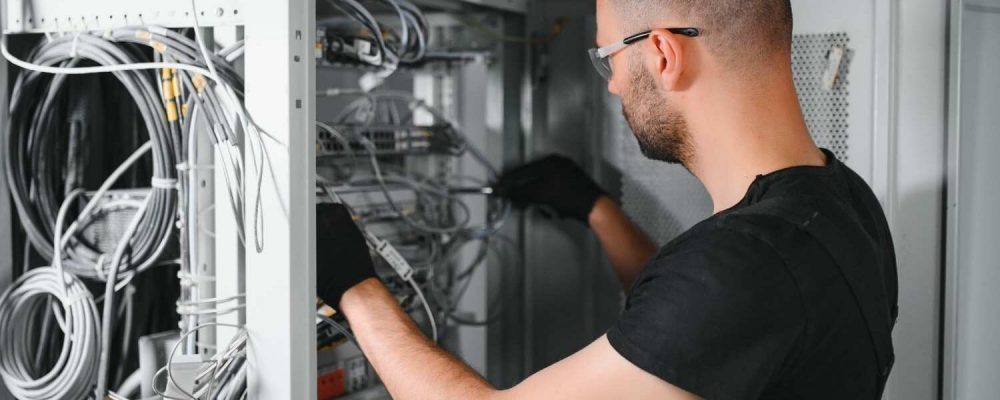Summary: Outdated wiring can leave businesses with unreliable connections and limited room to grow. Structured wiring brings order and consistency, linking data, voice, and devices through a standards-based design. This guide explains its subsystems, planning steps, and installation process, showing how the right approach extends network performance and supports future demands. Network Drops provides structured wiring built for business needs, delivering reliability, efficiency, and scalability

Every business runs on connectivity. From cloud apps and safe transactions to video conferencing and client Wi-Fi, practically every process runs on a network. However, the actual cabling that supports these systems has been patched together over time in several offices, factories, and campuses. This has resulted in cluttered pathways, unpredictable performance, and a network struggling to keep pace with growth.
But what happens when your cabling system cannot keep up? Have you observed slower upload speeds in peak hours or found the IT team spending too much time untangling cables to troubleshoot an issue? These are often the symptoms of an outdated wiring arrangement. Structured wiring solves this by offering orderly, standard systems in place of haphazard connections.
Most modern workplaces need interconnecting equipment, from personal computers (PCs), Internet protocol (IP) phones, and wireless access points to security systems. Unplanned wiring extensions will result in tangled cables that function unevenly and resist routine maintenance. A methodical, standards-based approach to networking is ensured by structured wiring, which offers dependable connections, troubleshooting simplicity, and future scalability.
As per an estimate from Future Market Insights (2024), the structured cabling market in the U.S. will reach $9.50 billion by 2034, at a compound annual growth rate of 11.05% from 2024, when it was $3.33 billion. Growth in fiber optics alone, clocking approximately 27% per annum, is a testimony to the demand for higher throughput, lower latency, and dense industry device connectivity.
This means enterprises interested in digital transformation, cloud, Internet of Things, and high-performance computing seek wiring that guarantees high throughput, low latency, and many devices per zone.
Structured wiring is divided into a hierarchically ranked set of subsystems. Each offers aspects of arrangement, performance, and modularity.
The cabling for this subsystem connects every work area outlet back to the wire closet or Telecommunications Enclosure. In commercial settings, horizontal cable runs consist of Cat5e, Cat6, higher twisted-pair copper, and sometimes fiber. For example, the closet termination for the horizontal runs would be patch panels or jacks, with jumpers or patch cords connecting from them to the switches.
Also known as the cable backbone, this subsystem carries aggregated traffic between telecommunications rooms, equipment rooms, and entrance facilities. It may also connect separate buildings in a campus environment. Backbone cabling often uses higher-capacity fiber optics or higher-grade copper media to manage aggregated loads.
The entrance facility is where internal cabling meets fiber, copper, or lines from external service providers. Demarcation points, grounding systems, surge protection, and the switch from external to interior structured wiring are all included.
This room is the hub where all of the cables are connected. This is the endpoint for both vertical cabling between floors and horizontal runs from work areas. Patch panels, switches, and cross-connects are located inside and control network communication between systems and devices.
One or more equipment rooms in larger networks may house servers, core switches, or major aggregation points. Consolidation points can also serve as sub-intermediate cross-connects in zones with high cabling density or multi-floor architectures.
These are the final legs: the outlet jacks, patch cords, and connectors that connect end devices. Labeling, field management, and plug-and-play convenience are all impacted by this subsystem’s architecture.

Structured wiring must conform to U.S. norms to assure performance, safety, and compatibility. Some of the key standards:
Adhering to these standards guarantees vendor compatibility, safeguards against future obsolescence, and maintains expected signal integrity.
Before installing any cables, a detailed design needs to be made. The design process establishes quality, scalability, and a reduced total cost of ownership.

With the design complete, technicians move on to field work. The structured wiring installation must adhere to standards, protect performance, and leave room for serviceability.
Installation does not yield success until it is tested and validated. For this, a robust testing protocol is essential.

Selecting a structured wiring contractor for a commercial project demands scrutiny of technical and operational criteria.
If capacity margins were included, a well-executed structured wiring deployment should last 10 to 15 years before undergoing a significant update. Standards such as ANSI/TIA aim to extend the commercial cabling lifecycle beyond ten years.
As business demands grow, structured cabling systems are often upgraded in stages rather than replaced immediately. Common steps include:
Conduit reserve capacity and modular cross-connects should not require tearing out the entire cabling plant due to careful pathway planning.

Every business runs on data, but that flow is only as strong as the cabling below it. An outdated or improvised installation will cause slowdowns, signal loss, and costly downtime. The problems mentioned above can be avoided with an installation done under a properly structured cabling system, which always respects stringent ANSI/TIA standards, uses certified materials, and is clearly documented for future use in an upgrade.
It ranges from fiber backbones to the PoE devices of high-speed transfer, all installed and engineered by Network Drops to provide scalable infrastructure in line with the growing user demands. Using intense tests and certifications coupled with years of field experience, Network Drops guarantees long-term serviceability to its clients.
You cannot afford network cabling shortcuts if your company depends on constant communication. Choose Network Drops’structured wire services for a system designed to manage compliance, growth, and capacity.
Schedule a site survey with Network Drops today and get a structured cabling plan designed to meet ANSI/TIA standards, reduce downtime, and support your business growth.
Structured wiring is a term for organized cabling that logically connects workstations to telecom and equipment rooms. For businesses, it usually prevents the mess and downtime associated with patchwork wiring, therefore making their networks more dependable and easier to upgrade.
Before requiring major adjustments, a well-planned and executed structured cabling system can serve a business for ten to fifteen years. Network Drops plans installations with future expansion and higher-grade cabling in mind to prolong the life of your investment.
Although you can attempt to self-install structured cabling, it is advisable to engage a specialist. Certified and branded structured cabling firms are better positioned to use modern methods and proper conduct, thus minimizing disruptions and improving network efficiency.
An investment in structured cabling can be protected by paying attention to threat flexibility, modularity, and the likely evolution of future threats. Opt for high-quality, certified components that, at a minimum, are compatible with higher data rates and greater data throughput. Make provisions for expansion, future loops, and spare networking equipment.
A full installation includes planning, cable routing, proper separation from electrical lines, certified terminations, grounding, and detailed labeling. Network Drops also provides full testing and documentation so your network is reliable from day one.
"*" indicates required fields
Scott Fcasni is the driving force behind Shock I.T. Support’s commercial datacomm cabling division, delivering expert solutions that power reliable, high-performance network infrastructures. With extensive experience in structured cabling and a commitment to precision, Scott ensures that every project—whether for small businesses or large enterprises—meets the highest standards of quality and scalability.